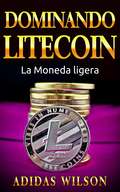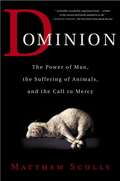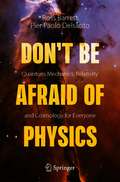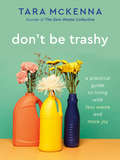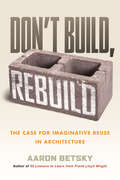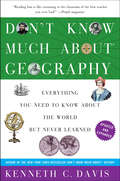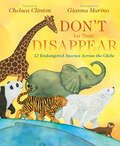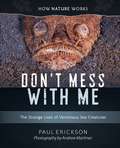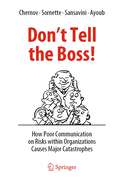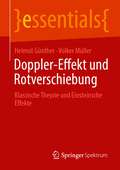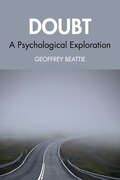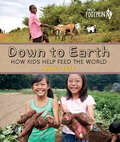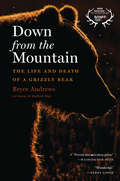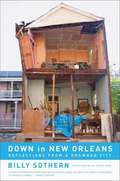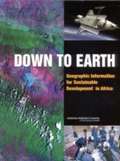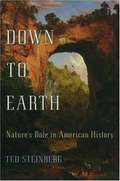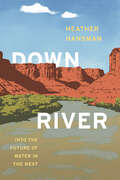- Table View
- List View
Dominando Litecon. La Moneda ligera.
by Jose Saul Agis Garcia Adidas WilsonNuestro autor es un empresario que siempre ha buscado resalatar la importancia de la criptomoneda a nivel global, tomando en consideración las necesidades de las personas que de igual manera se interesan en nuevos recursos intercambiarios. Con esta guía nos daremos cuenta de la importancia de conocer a las nuevas monedasm, en especial, las criptomonedas.
Dominion: The Power of Man, the Suffering of Animals, and the Call to Mercy
by Matthew ScullyAs an eye opening, painful and infuriating, insightful and rewarding book, Dominion is a plea for human benevolence and mercy, a scathing attack on those who would dismiss animal activists as mere sentimentalists, and a demand for reform from the government down to the individual.
Don't Be Afraid of Physics: Quantum Mechanics, Relativity and Cosmology for Everyone
by Ross Barrett Pier Paolo DelsantoWith the aid of entertaining short stories, anecdotes, lucid explanations and straight-forward figures, this book challenges the perception that the world of physics is inaccessible to the non-expert. Beginning with Neanderthal man, it traces the evolution of human reason and understanding from paradoxes and optical illusions to gravitational waves, black holes and dark energy. On the way, it provides insights into the mind-boggling advances at the frontiers of physics and cosmology. Unsolved problems and contradictions are highlighted, and contentious issues in modern physics are discussed in a non-dogmatic way in a language comprehensible to the non-scientist. It has something for everyone.
Don't Be Trashy: A Practical Guide to Living with Less Waste and More Joy
by Tara McKennaLearn how to dramatically reduce the waste you produce—and your stress levels—one sanity-saving step at a time in this accessible, practical guide from the creator of The Zero Waste Collective. &“You&’ll feel inspired by McKenna&’s thorough and accessible approach to understanding the why and how of reducing waste.&”—Julia Watkins, author of Simply Living Well Say goodbye to your bursting toiletries bag, fast fashion, and all the plastic crowding your pantry. It's time to build less trashy habits for a more sustainable and ethical life. With relatable stories, compassion, and a realistic perspective, Tara McKenna will show you how in this ultimate guide to going zero waste(ish). We're all trapped in a wasteful convenience-based cycle, but Don&’t Be Trashy offers an alternative: an approach to reducing waste that emphasizes progress over perfection. McKenna guides you month by month through a year of reducing consumption, covering:• Decluttering and turning off the flow of stuff into your home• Breaking up with fast fashion and developing a capsule wardrobe• Cutting off your supply of single-use plastic in your kitchen, cleaning supplies, and bathroom • Investing in home goods that'll last for decades without breaking the bank• And more! Ultimately, it's about changing your mindset to one of minimalism and conscious consumption—a mindset that&’s as good for your wallet and your well-being as it is for the planet. Don't Be Trashy will guide you to your best life—one with less waste and more joy!
Don't Build, Rebuild: The Case for Imaginative Reuse in Architecture
by Aaron BetskyIn a time of climate crisis and housing shortages, a bold, visionary call to replace current wasteful construction practices with an architecture of reuseAs climate change has escalated into a crisis, the reuse of existing structures is the only way to even begin to preserve our wood, sand, silicon, and iron, let alone stop belching carbon monoxide into the air. Our housing crisis means that we need usable buildings now more than ever, but architect and critic Aaron Betsky shows that new construction—often seeking to maximize profits rather than resources, often soulless in its feel—is not the answer. Whenever possible, it is better to repair, recycle, renovate, and reuse—not only from an environmental perspective, but culturally and artistically as well.Architectural reuse is as old as civilization itself. In the streets of Europe, you can find fragments from the Roman Empire. More recently, marginalized communities from New York to Detroit—queer people looking for places to gather or cruise, punks looking to make loud music, artists and displaced people looking for space to work and live—have taken over industrial spaces created then abandoned by capitalism, forging a unique style in the process. Their methods—from urban mining to dumpster diving—now inform architects transforming old structures today.Betsky shows us contemporary imaginative reuse throughout the world: the Mexican housing authority transforming concrete slums into well-serviced apartments; the MassMOCA museum, built out of old textile mills; the squatted city of Christiana in Copenhagen, fashioned from an old army base; Project Heidelberg in Detroit. All point towards a new circular economy of reuse, built from the ashes of the capitalist economy of consumption.
Don't Eat the Cleaners!: Tiny Fish with a Big Job
by Susan StockdaleEven though they live underwater, ocean animals have to get clean, just like we do. But they get it done in a weird and wonderful way.Just like you have to take a bath and brush your teeth, fish also have basic hygiene practices they have to follow every day. But their approach to cleanliness doesn't just take place underwater—it involves a network of larger ocean animals washed by small fish and shrimp called cleaners at coral reef cleaning stations around the world.Cleaners remove pesky parasites from their customers in return for a tasty meal, serving up to 2000 customers a day. Sea turtles, manta rays, and even sharks line up for a scrubbing in the busy stations, just like at a car wash. Some customers return 100 times daily. And they must remember the important rule if they want a washing by the cleaning crew: DON&’T EAT THE CLEANERS!Readers will delight in this colorful exploration of the remarkable teamwork among coral reef residents. Back matter features images of all 30 animals and a fun matching game: can you find the animals in the book?In her latest nonfiction work, award-winning author-illustrator Susan Stockdale once again proves her talent in creating engaging and entertaining nature books for young readers.
Don't Even Think About It: Why Our Brains are Wired to Ignore Climate Change
by George MarshallMost of us recognize that climate change is real, and yet we do nothing to stop it. What is this psychological mechanism that allows us to know something is true but act as if it is not? George Marshall's search for the answers brings him face to face with Nobel Prize-winning psychologists and the activists of the Texas Tea Party; the world's leading climate scientists and the people who denounce them; liberal environmentalists and conservative evangelicals. What he discovered is that our values, assumptions, and prejudices can take on lives of their own, gaining authority as they are shared, dividing people in their wake. <P><P>With engaging stories and drawing on years of his own research, Marshall argues that the answers do not lie in the things that make us different and drive us apart, but rather in what we all share: how our human brains are wired-our evolutionary origins, our perceptions of threats, our cognitive blindspots, our love of storytelling, our fear of death, and our deepest instincts to defend our family and tribe. Once we understand what excites, threatens, and motivates us, we can rethink and reimagine climate change, for it is not an impossible problem. Rather, it is one we can halt if we can make it our common purpose and common ground. Silence and inaction are the most persuasive of narratives, so we need to change the story. <P><P>In the end, Don't Even Think About It is both about climate change and about the qualities that make us human and how we can grow as we deal with the greatest challenge we have ever faced.
Don't Know Much About Geography: Everything You Need to Know About the World but Never Learned (The Don't Know Much About Series)
by Kenneth C. DavisAn “entertaining [and] eminently readable” exploration of our home planet from the New York Times–bestselling author of Don’t Know Much About History(Publishers Weekly).Geography is much more than naming countries on a map or memorizing state capitals. It’s the hub from which other disciplines radiate: meteorology, ecology, geology, oceanography, demographics, cartography, agricultural studies, economics, and political science. Yet many of us don’t know much about it. This fun and fascinating guide can change that!In addition to presenting plenty of geographical trivia to impress your friends, Kenneth C. Davis explores 21st-century topics of global concern, including the role of the Internet and technology in transforming the lives of people around the world, how so-called developing nations develop, sustainability, and debates over climate change and evolutionary science. This completely revised and updated version of Don't Know Much About Geography is an illuminating grand tour of planet Earth.“Reading [Kenneth C. Davis] is like returning to the classroom of the best teacher you ever had.” —PeopleA School Library Journal “Must-Read”
Don't Let Them Disappear
by Chelsea ClintonFrom the author of the #1 New York Times bestseller She Persisted comes a beautiful book about the animals who share our planet--and what we can do to help them survive.Did you know that blue whales are the largest animals in the world? Or that sea otters wash their paws after every meal? The world is filled with millions of animal species, and all of them are unique and special. Many are on the path to extinction.In this book, Chelsea Clinton introduces young readers to a selection of endangered animals, sharing what makes them special, and also what threatens them. Taking readers through the course of a day, Don't Let Them Disappear talks about rhinos, tigers, whales, pandas and more, and provides helpful tips on what we all can do to help prevent these animals from disappearing from our world entirely.With warm and engaging art by Gianna Marino, this book is the perfect read for animal-lovers and anyone who cares about our planet.Praise for Don't Let Them Disappear:"A winning heads up for younger readers just becoming aware of the wider natural world." --Kirkus Reviews"An inviting . . . appeal to care for the planet and its most vulnerable creatures." --Publishers Weekly
Don't Mess With Me: The Strange Lives Of Venomous Sea Creatures (How Nature Works #0)
by Paul Erickson Andrew MartinezThe role of venoms in nature … and in human medicine Why are toxins so advantageous to their possessors as to evolve over and over again? What is it about watery environments that favors so many venomous creatures? Marine biologist Paul Erickson explores these and other questions with astounding images from Andrew Martinez and other top underwater photographers. GREAT for teaching STEM Marine Biology Scorpions and brown recluse spiders are fine as far as they go, but if you want daily contact with venomous creatures, the ocean is the place to be. Blue-ringed octopi, stony corals, sea jellies, stonefish, lionfish, poison-fanged blennies, stingrays, cone snails, blind remipedes, fire urchins—you can choose your poison in the ocean. Venoms are often but not always defensive weapons. The banded sea krait, an aquatic snake, wriggles into undersea caves to prey on vicious moray eels, killing them with one of the world’s most deadly neurotoxins, which it injects through fangs that resemble hypodermic needles.
Don't Tell the Boss!: How Poor Communication on Risks within Organizations Causes Major Catastrophes
by Didier Sornette Dmitry Chernov Ali Ayoub Giovanni SansaviniThe book reviews existing research on the challenges of voice and silence in organizations. After a major disaster, when investigators are piecing together the story of what happened, a striking fact often emerges: before disaster struck, some people in the organization involved were aware of dangerous conditions that had the potential to escalate to a critical level. But for a variety of reasons, this crucial information did not reach decision-makers. So, the organization moved ever closer to catastrophe, effectively unaware of the possible threat—despite the fact that some of its employees could see it coming.What is the problem with communication about risk in an organization, and why does this problem exist? What stops people in organizations or project teams from freely reporting and discussing critical risks? This book seeks to answer these questions, starting from a deep analysis of 20 disasters where the concealment of risks played a major part.These case studies are drawn from around the world and span a range of industries: civil nuclear power, coal, oil and gas production, hydropower energy, metals and mining, space exploration, transport, finance, retail manufacturing and even the response of governments to wars, famines and epidemics.Together, case studies give an insight into why people hesitate to report risks—and even when they do, why their superiors often prefer to ignore the news.This helps to explain more generally why people dread passing on bad news to others—and why in the workplace they prefer to keep quiet about unpleasant facts or potential risks when they are talking to superiors and colleagues.The discussion section of the book includes important examples of concealment within the Chinese state hierarchy as well as by leading epidemiologists and governments in the West during the novel coronavirus outbreak in Wuhan in 2019-2020. The full picture of the very early stage of the COVID-19 pandemic remains unclear, and further research is obviously needed to better understand what motivated some municipal, provincial and national officials in China as well as Western counterparts to obfuscate facts in their internal communications about many issues associated with the outbreak.
Don't Throw It Away!
by Amy TaoReduce, recycle, and reuse. We can all help Earth, if we choose. In this poem, kids learn about the differences between recycling, compost, and hazardous waste.
Doppler-Effekt und Rotverschiebung: Klassische Theorie und Einsteinsche Effekte (essentials)
by Helmut Günther Volker MüllerDer Doppler-Effekt ist die Frequenzänderung von Wellen bei einer Relativgeschwindigkeit von Sender und Empfänger. So wird die Sirene einer Feuerwehr bei einer Vorbeifahrt deutlich tiefer. Der klassische Doppler-Effekt erlaubt es, den Bewegungszustand des Trägermediums der Wellen zu bestimmen. Für Licht im Vakuum ist die relativistische Gangverzögerung einer bewegten Uhr zu berücksichtigen. Die Frequenzverschiebung hängt dann nur von der Relativgeschwindigkeit ab. Es gibt keinen Bewegungszustand des Vakuums. Der Leser wird in die Lichtausbreitung in Gravitationsfeldern eingeführt. Die Autoren demonstrieren, dass Licht von kompakten Quellen eine gravitative Rotverschiebung erfährt und dass um Schwarze Löcher eine unendliche Rotverschiebung zu beobachten ist. Der Leser erfährt, warum im Kosmos zusätzlich eine kosmologische Rotverschiebung auftritt.
Dormilones de verano (Spanish Edition): Animales aletargados
by Melissa Stewart¡Edición en español! Todos sabemos que hay animales que hibernan en el invierno. Pero, es momento de descubrir los animales que duermen todo el verano. Una fascinante lectura de no ficción para niños de 6 a 9 años que aman los animales y la naturaleza, ¡y que quieren aprender sobre las diferentes especies que dormitan en verano!Spanish language edition! Everyone knows about animals that hibernate in the winter. But it's time to discover animals that sleep all summer long.A fascinating nonfiction read for 6-9-year-old kids who love animals and nature and want to learn about the different species that estivate!En todas las clases de ciencias se discute sobre los animales que hibernan durante los meses de invierno, pero pocos saben sobre los animales que practican la estivación, un sueño prolongado durante los periodos calientes o secos.La doble capa textual ayuda a los lectores a darse cuenta de las razones por las cuales los animales aletargados dormitan, ya sea porque el clima cálido amenaza el suministro de alimentos o para evitar el aumento de la temperatura corporal.Desde la mariquita hasta la salamandra, desde el pez pulmonado africano hasta el erizo del desierto, aprende sobre doce animales que estivan y sus hábitos, tanto mientras duermen como cuando están despiertos, explicado mediante un texto claro e ilustraciones elegantes en acuarela.All science classrooms discuss animals that hibernate during winter months, but few know about animals that estivate—a prolonged sleep during hot or dry periods.Dual layers of text awaken readers to the reasons estivating animals become dormant—whether it's because warm weather threatens food supply or to avoid increased body temperatures.From the ladybug to the salamander, from the lungfish to the desert hedgehog, learn about twelve estivating animals and their habits—both when sleeping and awake—explained through clear text and elegant watercolor illustrations.
Double-Diffusive Convection
by Timour RadkoDouble-diffusive convection is a mixing process driven by the interaction of two fluid components which diffuse at different rates. Leading expert Timour Radko presents the first systematic overview of the classical theory of double-diffusive convection in a coherent narrative, bringing together the disparate literature in this developing field. The book begins by exploring idealized dynamical models and illustrating key principles by examples of oceanic phenomena. Building on the theory, it then explains the dynamics of structures resulting from double-diffusive instabilities, such as the little-understood phenomenon of thermohaline staircases. The book also surveys non-oceanographic applications, such as industrial, astrophysical and geological manifestations, and discusses the climatic and biological consequences of double-diffusive convection. Providing a balanced blend of fundamental theory and real-world examples, this is an indispensable resource for academic researchers, professionals and graduate students in physical oceanography, fluid dynamics, applied mathematics, astrophysics, geophysics and climatology.
Doubt: A Psychological Exploration
by Geoffrey BeattieBlending the latest academic research with case studies of famous figures, this highly insightful book presents ‘doubt’ as a central concept for psychology. It is a concept which has been oddly neglected in the past, despite its ubiquitous nature and far-reaching influence. Exploring everything from self-doubt and impostor syndrome to the weaponisation of doubt with respect to climate change and the marketing of cigarettes, bestselling author Geoffrey Beattie navigates readers through the various ways doubt can start and develop, changing the individual in the process. Written in Beattie’s distinctive and engaging style, Doubt takes the reader into the lives of transformational thinkers, artists, scientists and writers to explore how and why doubt was crucial in their lives and how the likes of Kafka, Jung, Picasso and Turing succumbed to doubt or learned to control it. Beattie argues that doubt is central to the self; it can be either a safeguarding mechanism or a distraction, rational or irrational, systematic or random, healthy or pathological, productive or non-productive. The book helps readers to recognise how doubt may have been operating in their own lives and to identify how and when it has been used against us – for example, to prevent climate action – and at what personal and societal cost. Presenting a compelling case for why doubt cannot be ignored, this book is of major interest to academics from a wide range of disciplines, including social and cognitive psychology, clinical and counselling psychology, sport psychology, sociology, business studies, politics, art and literature, as well as the general public, who may well see something of themselves in its pages.
Doughnut Economics: Seven Ways to Think Like a 21st-Century Economist
by Kate Raworth*The Sunday Times Bestseller*A Financial Times Book of the Year*A Forbes Book of the Year*Winner of the Transmission Prize 2018*Longlisted for the FT/McKinsey Business Book of the Year Award 2017*Porchlight &“Best Business Book of 2017: Current Events & Public Affairs&”The book that redefines economics for a world in crisis.Economics is the mother tongue of public policy. It dominates our decision-making for the future, guides multi-billion-dollar investments, and shapes our responses to climate change, inequality, and other environmental and social challenges that define our times.Pity then, or more like disaster, that its fundamental ideas are centuries out of date yet are still taught in college courses worldwide and still used to address critical issues in government and business alike.That&’s why it is time, says renegade economist Kate Raworth, to revise our economic thinking for the 21st century. In Doughnut Economics, she sets out seven key ways to fundamentally reframe our understanding of what economics is and does. Along the way, she points out how we can break our addiction to growth; redesign money, finance, and business to be in service to people; and create economies that are regenerative and distributive by design.Named after the now-iconic &“doughnut&” image that Raworth first drew to depict a sweet spot of human prosperity (an image that appealed to the Occupy Movement, the United Nations, eco-activists, and business leaders alike), Doughnut Economics offers a radically new compass for guiding global development, government policy, and corporate strategy, and sets new standards for what economic success looks like.Raworth handpicks the best emergent ideas—from ecological, behavioral, feminist, and institutional economics to complexity thinking and Earth-systems science—to address this question: How can we turn economies that need to grow, whether or not they make us thrive, into economies that make us thrive, whether or not they grow?Simple, playful, and eloquent, Doughnut Economics offers game-changing analysis and inspiration for a new generation of economic thinkers.&“This is sharp, significant scholarship . . . Thrilling.&”—Times Higher Education&“Raworth&’s magnum opus . . . Fascinating.&”—Forbes&“Doughnut Economics shows how to ensure dignity and prosperity for all people.&”—Huffington Post
Down Comes The Rain (Let's-Read-And-Find-Out-Science)
by Franklyn M. BranleyAfter rain comes down, the sun comes out and dries the puddles. But the water isn't gone. The heat from the sun has turned it into water vapor-it has evaporated. Eventually, this moisture in the air condenses to form new clouds. Soon the rain will fall again. Read on to find out all the ups and downpours of the water cycle!
Down Comes the Rain (Let's-Read-and-Find-Out Science 2)
by Dr. Franklyn M. BranleyRead and find out about the ups and downpours of the water cycle in this colorfully illustrated nonfiction picture book.Down Comes the Rain is a clear and engaging look into the stages of the water cycle. After rain comes down, the sun comes out and dries the puddles. But the water isn’t gone. The heat from the sun has turned it into water vapor—it has evaporated. Eventually, this moisture in the air condenses to form new clouds. Soon the rain will fall again. Featuring rich vocabulary bolded throughout the text, this updated edition includes a glossary and a find out more section with an activity about the water cycle. Both the text and the artwork were vetted for accuracy by Don W. Hen and Dr. Sonia M Kreidenweis, Professor of Atmospheric Science at Colorado State University.This is a clear and appealing science book for early elementary age kids, both at home and in the classroom. It's a Level 2 Let's-Read-and-Find-Out, which means the book explores more challenging concepts for children in the primary grades. The 100+ titles in this leading nonfiction series are:hands-on and visualacclaimed and trustedgreat for classroomsTop 10 reasons to love LRFOs:Entertain and educate at the same timeHave appealing, child-centered topicsDevelopmentally appropriate for emerging readersFocused; answering questions instead of using survey approachEmploy engaging picture book quality illustrationsUse simple charts and graphics to improve visual literacy skillsFeature hands-on activities to engage young scientistsMeet national science education standardsWritten/illustrated by award-winning authors/illustrators & vetted by an expert in the fieldOver 130 titles in print, meeting a wide range of kids' scientific interestsBooks in this series support the Common Core Learning Standards, Next Generation Science Standards, and the Science, Technology, Engineering, and Math (STEM) standards. Let's-Read-and-Find-Out is the winner of the American Association for the Advancement of Science/Subaru Science Books & Films Prize for Outstanding Science Series.
Down To Earth: How Kids Help Feed the World (Orca Footprints #1)
by Nikki TateKids all over the world help collect seeds, weed gardens, milk goats and herd ducks. From a balcony garden with pots of lettuce to a farm with hundreds of cows, kids can pitch in to bring the best and freshest products to their families' tables—and to market. Loaded with accessible information about the many facets of farming, Down to Earth takes a close look at everything from what an egg carton tells you to why genetic diversity matters—even to kids.
Down from the Mountain: The Life and Death of a Grizzly Bear
by Bryce AndrewsThe story of a grizzly bear named Millie: her life, death, and cubs, and what they reveal about the changing character of the American West.Grand Prize Winner of the Banff Mountain Book CompetitionAn “ode to wildness and wilderness” Down from the Mountain tells the story of one grizzly in the changing Montana landscape (Outside Magazine).Millie was cunning, a fiercely protective mother to her cubs. But raising those cubs in the mountains was hard, as the climate warmed and people crowded the valleys.There were obvious dangers, like poachers, and subtle ones, like the corn field that drew her into sure trouble. That trouble is where award-winning writer, farmer, and conservationist Bryce Andrews’s story intersects with Millie’s.In this “welcome and impressive work” he shows how this drama is “the core of a major problem in the rural American West—the disagreement between large predatory animals and invasive modern settlers”—an entangled collision where the shrinking wilds force human and bear into ever closer proximity (Barry Lopez).“The two sides of Bryce Andrews—enlightened rancher and sensitive writer—appear to make a smooth fit . . . Precise and evocative prose.” —The Washington Post“Rife with lyrical precision, first-hand know-how, ursine charisma, and a narrative jujitsu flip that places all empathy with his bears, Down from the Mountain is a one-of-a-kind triumph even here in the home of Doug Peacock and Douglas Chadwick.” —David James Duncan, author of The River Why “Would that we had more nature writing like Bryce Andrews’s fantastic second book, Down from the Mountain . . . A subtle and beautifully unexpected book.” —Literary Hub
Down in New Orleans: Reflections from a Drowned City
by Billy SothernBilly Sothern guides the reader on a journey through post-Katrina New Orleans and an array of indelible images--prisoners abandoned in their cells with waters rising, a longtime New Orleans resident of Middle Eastern descent unfairly imprisoned following the hurricane, trailer-bound New Orleanians struggling to make ends meet but celebrating with abandon during Mardi Gras--and offers a powerful vision of what Katrina has meant to New Orleans and what it still means to the nation at large.
Down to Earth: Geographic Information for Sustainable Development in Africa
by Committee on the Geographic Foundation for Agenda 21In 1992, world leaders adopted Agenda 21, the work program of the 1992 U. N. Conference on Environment and Development. This landmark event provided a political foundation and action items to facilitate the global transition toward sustainable development. The international community marked the tenth anniversary of this conference in Johannesburg, South Africa, in August 2002. "Down to Earth, a component of the U. S. State Department's "Geographic Information for Sustainable Development" project for the World Summit, focuses on sub-Saharan Africa with examples drawn from case-study regions where the U. S. Agency for International Development and other agencies have broad experience. Although African countries are the geographic focus of the study, the report has broader applicability. "Down to Earth summarizes the importance and applicability of geographic data for sustainable development and draws on experiences in African countries to examine how future sources and applications of geographic data could provide reliable support to decision-makers as they work towards sustainable development. The committee emphasizes the potential of new technologies, such as satellite remote-sensing systems and geographic information systems, that have revolutionized data collection and analysis during the last decade.
Down to Earth: Nature's Role in American History
by Ted SteinbergDown to Earth offers a sweeping history of our nation, one that for the first time places the environment at the very center of our story. Writing with marvelous clarity, historian Ted Steinberg sweeps across the centuries, re-envisioning the story of America as he recounts how the environment has played a key role in virtually every social, economic, and political development.
Downriver: Into the Future of Water in the West
by Heather HansmanFrom an award-winning journalist and river raft guide, “a must-read for anyone who loves rivers or is concerned about the future of the West” (Outside magazine).The Green River, the most significant tributary of the Colorado River, runs 730 miles from the glaciers of Wyoming to the desert canyons of Utah. Meandering through ranches, cities, national parks, endangered fish habitats, and some of the most significant natural gas fields in the country, the river provides water for 33 million people. The Green is crucial, overused, and at risk, now more than ever.Fights over the river’s water are longstanding, intractable, and only getting worse as the West gets hotter and drier and more people depend on the river with each passing year. As an environmental reporter, Heather Hansman knew about these fights, but she felt driven to see them from a different perspective—from the river itself. So she set out on a journey, in a one-person inflatable pack raft, to paddle the river from source to confluence and see what the experience might teach her. Mixing lyrical accounts of quiet paddling through breathtaking beauty with nights spent camping solo and lively discussions with people met along the way, Downriver is the story of that journey, a foray into the present—and future—of water in the West.“An energizing mix of travelogue and investigative journalism.” —Publishers Weekly“ A worthy updating of a core library containing such works as Marc Reisner’s Cadillac Desert and Philip Fradkin’s A River No More. An insightful look into the unsustainability of western waterways.” —Kirkus Reviews“Explores the water emergency with remarkable calm and even-handedness.” —New Republic
